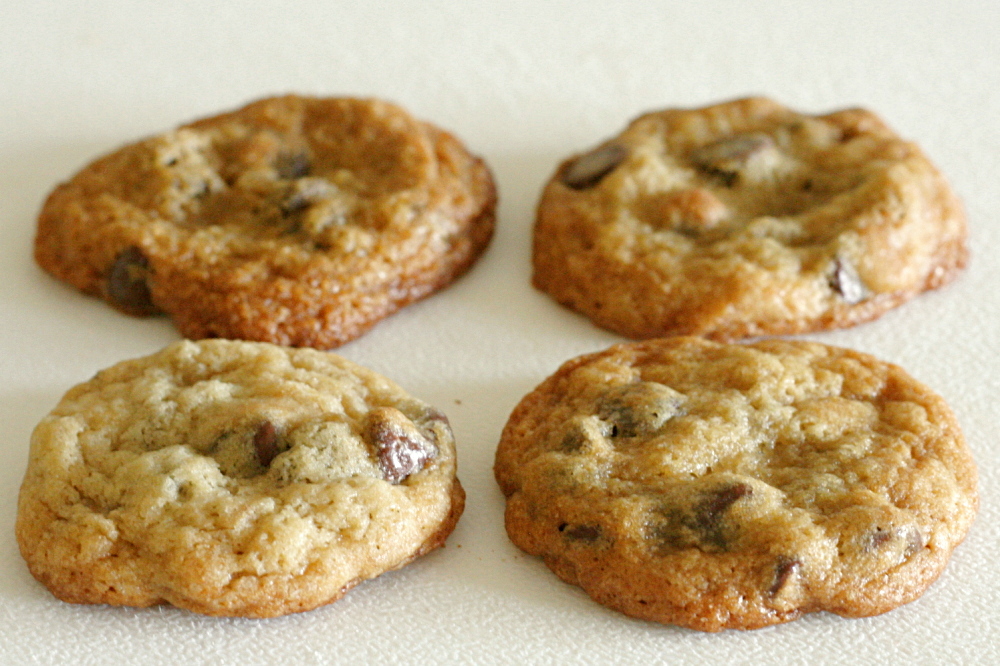
clockwise from upper left: #4 (whole wheat) #3 (yeast) #1 (control) #2 (bread)
I’m a scientist. I spent years working in labs, and I kid you not that what I did was combine ingredients and bake them. I did not, however, eat the results of those experiments. My cooking lately has become increasingly similar to my lab work. Notes are laboriously taken, samples are diligently labeled, variables are carefully controlled. But in this case, I do get to eat the results. It’s a key difference.
This comparison is a little different than ones I’ve done in the past, because I wasn’t looking at different recipes. Instead, I used a master recipe and varied just one component in each batch of cookies. I mixed the dough, flash-froze the dough balls, transferred them to plastic bags, then took them on a 9-hour (make that 10-hour, because we missed a turn) drive. I baked each batch without adjusting the oven temperature in between. I had four tasters (including myself). I did not tell the other tasters what the differences between the cookies were.
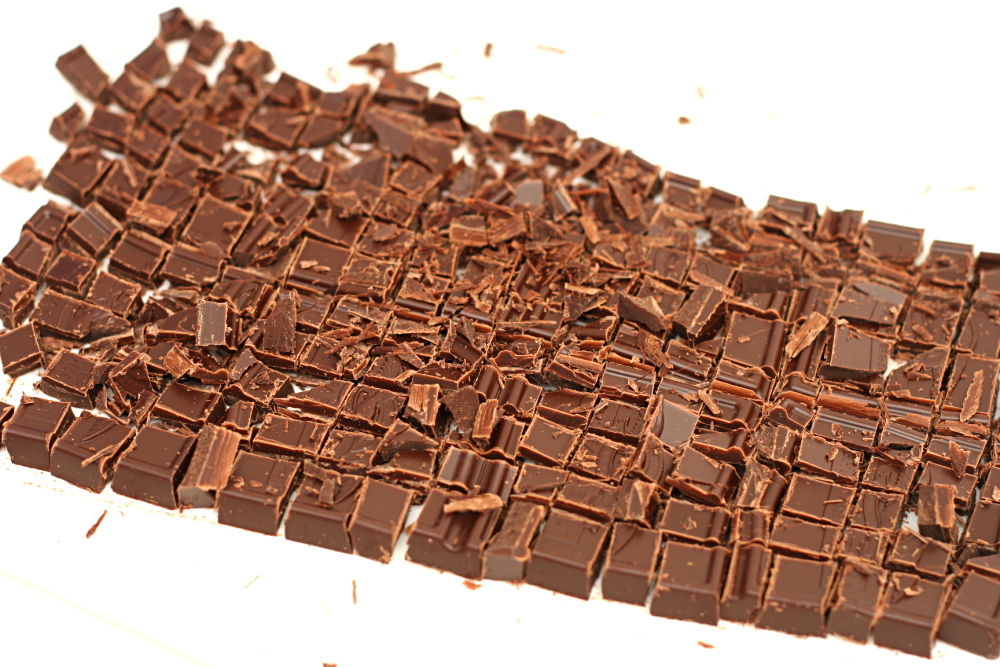
Batch #1: This was my control recipe. A fairly standard chocolate chip cookie recipe, the only difference between this recipe and Tollhouse is an increase in the ratio of brown sugar to white sugar.
Batch #2: This was the same as Batch #1, except I used bread flour instead of all-purpose flour.
Batch #3: This was the same as Batch #1, except I added 2 teaspoons instant yeast. The idea to use yeast in chocolate chip cookies came from this recipe, which I liked quite a bit. (Thanks to branny for bringing this to my attention.) However, since the recipe differs from traditional chocolate chip cookie recipes in a number of ways – bread flour, browned butter, less butter per flour – I couldn’t be sure what roll the yeast played. This is what spurred this whole comparison.
Batch #4: This was the same as Batch #1, except I used whole wheat pastry flour instead of all-purpose flour.
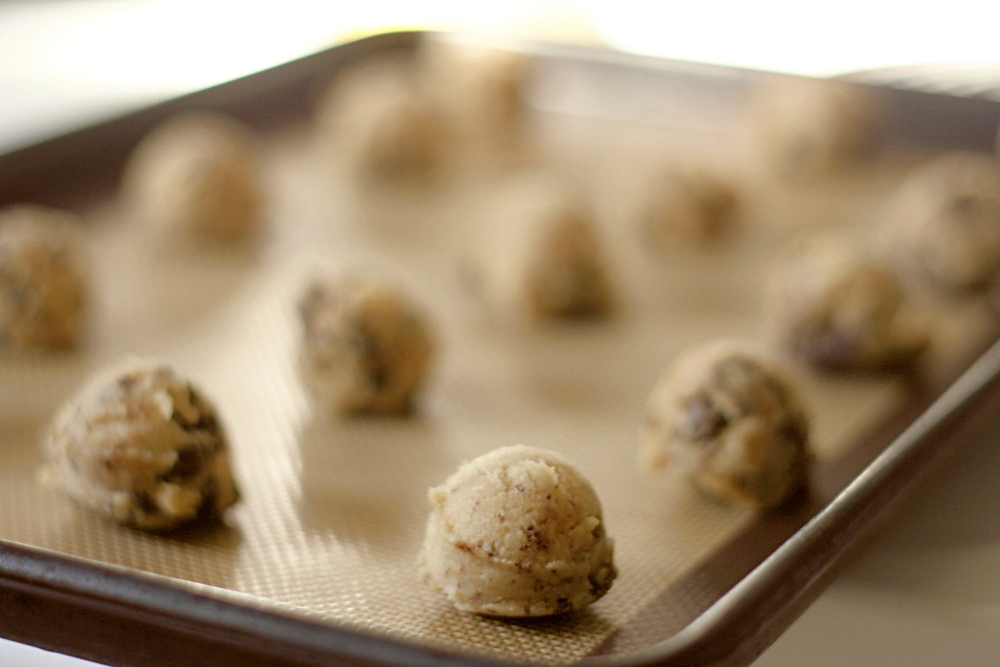
The results:
Batch #1: Frankly, these aren’t my ideal chocolate chip cookies. That’s okay, because the purpose of this experiment was to identify differences, not necessarily find an ideal. (My notes say, simply, “soft.” So much for laborious note-taking!) They tend to be a little too flat, a little greasy, and, yes, very soft.
Batch #2: Alton Brown knows what he’s doing when he uses bread flour to make his cookies chewy. These were the overall favorite, with a nice balance between the greasy side and the cakey side – i.e., chewy.
Batch #3: Yeast apparently makes cookies fluffy. We found this one a little too cakey for our tastes.
Batch #4: I probably should have substituted just half of the all-purpose white flour for whole wheat pastry flour. A complete substitution resulted in cookies that were greasy, flat, and grainy. The flavor was a bit nutty. Kind of what you’d expect from whole wheat cookies, I suppose.
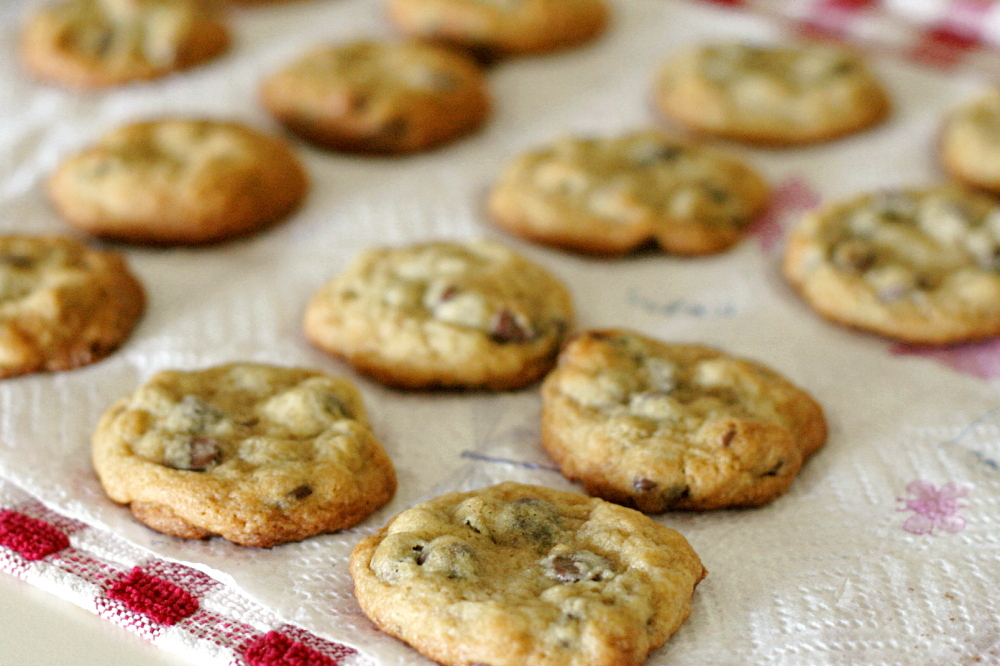
Overall conclusions:
- Bread flour makes cookies chewier, taller, and less greasy (or drier).
- Yeast makes cookies more cakey.
- A 1:1 substitution of whole wheat pastry flour for all-purpose flour in cookies is a bad idea.
- I am obsessive, at least when it comes to cookies!
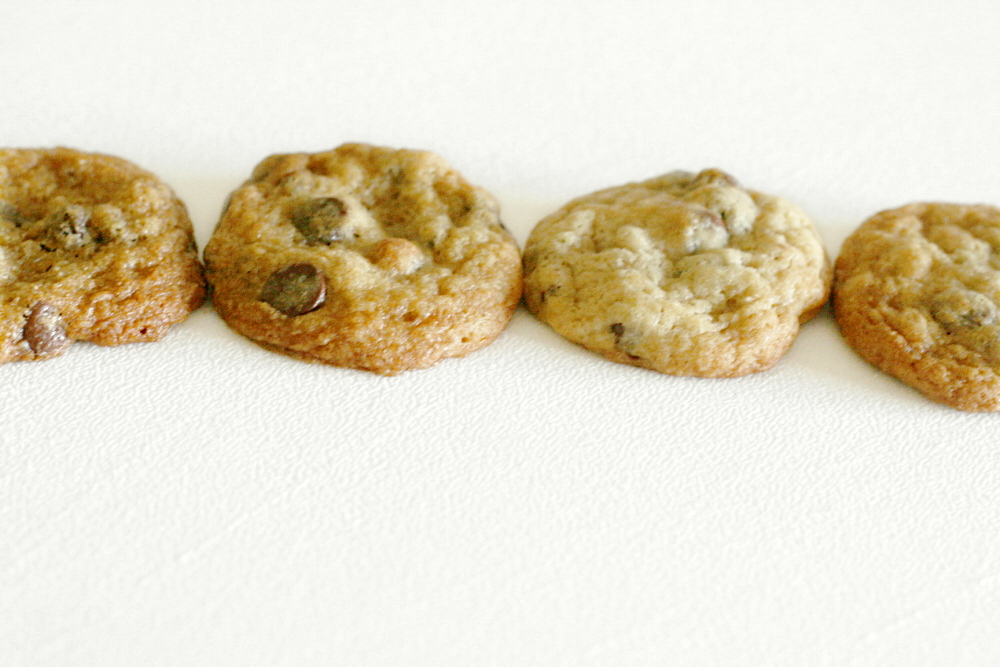
left to right: #4 (whole wheat) #3 (yeast) #2 (bread) #1 (control)
One year ago: Summer Rolls
Chocolate Chip Cookies, previously:
Chocolate Chip Cookies (4 recipes)
Chocolate Chip Cookie (Cook’s Illustrated’s “Perfect”)
Master Recipe for Chocolate Chip Cookie Experiments
Please note that I’m not saying that you can’t make good cookies without bread flour, or that yeast will make all cookies too cakey. These were just the results with this particular recipe. All I’m saying is that yeast makes cookies cakier, and bread flour makes them chewier.
2¼ cups (10.8 ounces) all-purpose flour
1 teaspoon table salt
1 teaspoon baking soda
16 tablespoons (2 sticks) unsalted butter, at room temperature
¼ cup (1.75 ounces) sugar
1¼ cups (8.75 ounces) brown sugar
2 eggs
2 teaspoons vanilla extract
2 cups (12 ounces) semisweet chocolate chips
1. Adjust an oven rack to the middle position. Heat the oven to 375F. Line a baking sheet with parchment paper or a silicone baking mat. In a small bowl, combine the flour, salt, and baking soda.
2. In the bowl of a stand mixer fitted with the paddle attachment (or a hand mixer, or a spoon or whatever), beat the butter until creamy. Add the sugars and beat on medium speed until fluffy. Add the eggs, one a time, mixing for one minute after each addition. Add the vanilla. Reduce the mixer speed to low and add the flour, mixing just until almost combined. Add the chocolate chips and pulse the mixer on low speed until the chips are dispersed and the flour is incorporated.
3. Drop rounded tablespoons of dough onto the lined baking pan, spaced an inch or two apart. Bake the cookies for 7-10 minutes, until slightly browned around the edges and just set in the middle. Cool the cookies for at least 2 minutes on the sheet before transferring to a rack to finish cooling. (If they still seem fragile after 2 minutes of cooling, you can just leave them on the sheet to cool completely.)






Interesting results!! And hey, there’s nothing wrong with having a chocolate chip cookie obsession 😀
The bread flour cookie (I think) even looks the tastiest! It is so much better when you get to eat your results–work might be a lot more fun it my ‘ingredients’ didn’t do major damage 😉
Bridget, I love that you do these “lab experiments.” Selfishly I am going to hope that my friends don’t read your blog and start expecting this type of project from me! It’s interesting to see how those variations actually affect the end product. Love your site. =)
I was already a fan of your “white cake experiments” but this post is also very usefull : I wanted to make chocolate chip cookies but didn’t know which recipe to use ! Now I know :o)
Oh dear, a mad scientist indeed 😉 Maybe King Arthur or Bob’s Red Mill has some tips about using whole wheat flour for choc chip cookies 🙂
I’m glad you are obsessive, because I love reading these posts 🙂 What a great experiment!
I am a scientist, so I can’t bring myself to bring my work home and do something like this, but I always LOVE reading about your results! I’ve never made made CCC with bread flour, so I’ll have to try it!
I love your obsessive side! Thanks for clearing up the bread flour issue, good to know.
Great CCC post. I too love experimenting, comparing and learning in the kitchen. The bread flour makes a lot of sense, especially as it relates to something I read in Shirley Corriher’s book, Bakewise. She explained that back when Ruth Wakefield developed the CCC recipe, the flour would have had a higher protein content, more like today’s bread flour. The chemistry of our AP flour has changed through the decades, but not the classic Toll House cookie recipe, which explains why it isn’t anyone’s favorite anymore.
Another key to great CCC is refrigerating the dough, something they routinely did at the Toll House Inn. Corriher, confirms the positive effect refrigerating the dough at least 24 hours and up to 3 days has on the cookies, with those chilling longest being voted the best.
Thanks Mrs. Scientist! I love your comparison posts! It’s nice to know I can use that bread flour I have for something other than bread, as I don’t make bread very often.
Great post…I love reading the notes and seeing what the differences are in other variations. I just tried the famous NYTimes cookie recipe but my notes are just “yum.” 🙂
hi bridget,
awesome experiment.
i wonder if you would have enjoyed the bread flour cookie even more if you used instant yeast with that variation (so, combining batch #2 & 3 into 1 variation basically). i actually might try that today and report back!
one thing i would be interested to see would be on leaveners comparing these variations: baking soda + baking powder; baking soda only (or an extra yolk since you’ve done this already); omit b.soda and add additional egg (2 eggs per 2-1/4c flour); instant yeast + bread flour.
or maybe the inclusion of sour cream (1/2c), yogurt instead of eggs? buttermilk v milk? milk + vinegar?
it’s endless ; p
I love your posts comparing recipes! You rock!
These are such fun posts to read. I love that you take the time to desconstruct and resconstruct the process… especially for chocolate chip cookies!
awesome. way to put your science background to good use. 🙂
Great post. I am always trying to figure out what key ingredients lead to what results.
Ha ha…I love your diligence in trying to find the perfect cookie recipe.
Going to such lengths to improve on your cookie baking skills, cannot be anything but a good idea!
All but the last were delicious. The experiment convinced me that I don’t have a refined pallet at all.
Sid – Heehee. And I think it was the snickerdoodles that B4B thought one tasted good and one sucked, and you were like, “um, they taste the same to me.”
This and your recent recipes all look wonderful! This was a great post – thank you for sharing! I’m a huge CCC fan and now I’m tempted to get a few to munch on. I’ve been on a slight commenting hiatus with my busy schedule lately… but it’s great to catch up and see what’s cooking in your kitchen!
I love your obsessiveness with choc chip cookies. I’m going to have to try bread flour.
Alton Brown does indeed know what he’s talking about! I’ve been making “the Chewy” in variations all year, but I finally sat down and made them properly this week and am 100% in love!
Thanks for the info… never would have thought of adding yeast to cookies…
I love that you did this experiment. I usually lack the patients for such experiments so I’m glad you are out there doing it:) I’m going to try the chewy cookie…AB is so smart:)
It was a fun post to read. You are so dedicated for the good cause. So worth it. I just took a mental note of all your observations. I love chewy cookies. Gotta admit, American cookies are the best. French people can bake beautiful things but they can’t bake excellent cookies
I thoroughly enjoyed the experiment and look forward to testing the bread flour and yeast options too! Thanks!
I love that you are so obsessive about chocolate chip cookies, because I love such kinds of experimentation, but can never really get myself to do it! Thanks!
Have I mentioned lately that you’re crazy? Because, um, YOU ARE. And that makes you awesome. And that opinion is not just because I only have 45 minutes of work left and am becoming delirious from listening to operators complain a lot, yada yada yada. While I’ve never tried yeast in a CCC, I’m now quite intrigued…
What a great idea. Since I still feel like I’m a novice I don’t venture too far off the well mapped road of a recipe. I guess that’s how you know you’ve advanced to “adventurer” status. Love the experiment — will look forward to more.
I LOVED this post! Such interesting and useful results–thank you!!
Thank you for sharing your experiment with us. I will definitely give bread flour a try with my favorite cookie recipe!
Thank you for sharing your experiments. I have been / am testing a ton of cookie recipes at this point to find one I really like and your suggestions are additional material to me.
I also tried at some point to substitute part of the all purpose flour by almond flour, but the result was grainy and not chewy.
I will let you know as I keep going as well and will keep on reading your blog 🙂